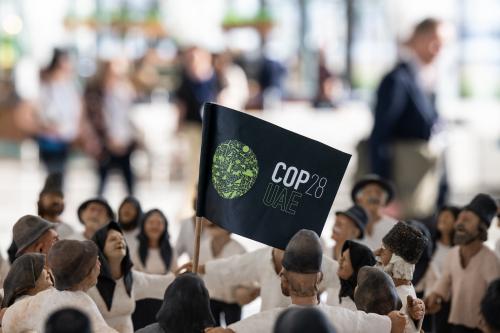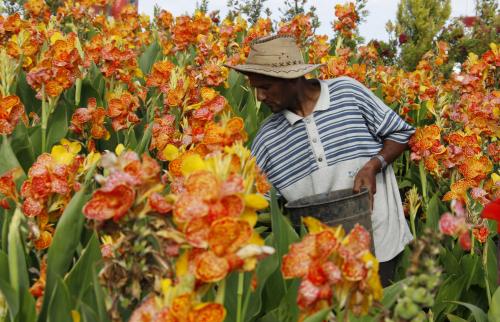Following the United Nations Climate Change Conference, or COP28, in Dubai in December 2023, two of our Brookings colleagues, Samantha Gross and Landry Signé, pointed out that the international community is failing to mobilize the resources to help countries improve their resilience to climate change. This is particularly pertinent as people in the worst affected communities are increasingly compelled to migrate in search of safety and stability. Apart from disasters and extreme weather displacing people, climate change is a “threat multiplier” that exacerbates instability, threats to security, and existing inequalities that drive people from their homes.
Climate displacement is predominantly internal and regional, so it puts more economic pressure on receiving communities which are often highly vulnerable to the effects of climate change themselves. According to the U.N. High Commissioner for Refugees (UNHCR), low- and middle-income countries in the Global South host 75 percent of existing refugees and other displaced populations. Some of these countries are the most prone to climate change’s damaging effects, even though they have least contributed to the problem. In affected countries, many people are migrating from rural to urban areas, further straining local resources and public services, and raising the risks of social tension.
Given the mounting challenges of climate change, including large-scale displacement, Europe and the United States should consider extending preferential trade arrangements as an innovative policy approach to supplement the Loss and Damage Fund that was operationalized at COP28 to help the most vulnerable countries. By itself, the pledges committed to the fund are gravely insufficient to meet the actual costs of addressing climate damages and adaptation financing needs.
The nexus of climate change and displacement
Most climate-related migration occurs within affected countries. In 2022, an estimated 32.6 million internal displacements were recorded as a result of natural disaster incidents, primarily severe floods, storms, and droughts. The historic floods in Pakistan resulted in one-quarter of total internal displacements worldwide in 2022 and 1.1 million movements were recorded in Somalia after a severe drought. By 2050, the World Bank predicts 216 million people could be internally displaced by climate change, concentrated principally in sub-Saharan Africa, East Asia, and South Asia.
Yet the growing impact of climate change and environmental degradation also poses longer-term threats to livelihoods, employment, food security, water access, and physical safety. This will increase pressure for cross-border movement while governments struggle to implement effective mitigation and adaptation measures, particularly for the citizens of small island states who face the acute threat of rising sea levels. As secondary political, socioeconomic, and security effects rise, countries in the Global North may also see even higher numbers of migrant arrivals. In the absence of international frameworks managing climate-related displacement, migrants risk falling into the hands of human smugglers and irregularity1 in destination countries.
Trade compacts for refugee-hosting communities as a model
The Global Compact on Refugees (GCR) offers ideas that could help strengthen the resilience of countries in the Global South and assist them in mitigating the most severe consequences of funding shortages and climate displacement. The GCR was adopted by almost all members of the U.N. General Assembly in the aftermath of the European migration crisis of 2015-2016 and affirms a collective moral duty to help refugees and assist their host communities. It also advances a list of innovative policy recommendations to support these goals.
One such policy idea revolves around the extension of trade facilitation arrangements for countries that host large numbers of refugees in return for allowing refugees access to formal employment. This idea was first implemented by the EU-Jordan Compact, and more recently advocated by the U.N. Development Program’s (UNDP) “Turkey Compact.” According to the UNDP’s calculations, the adoption of the compact by the EU for agricultural products and the United States and Canada for textiles would expand Turkish exports by an estimated $7.8 billion. In turn, it would create almost 284,000 jobs in Turkey, excluding secondary job creation effects, of which 20 percent would go to Syrian refugees. Finally, the compact could add 0.82 percent to Turkey’s overall GDP. If implemented, the UNDP’s policy proposal would offer a solid example of enhancing self-reliance for refugees and the resilience of host communities—two central objectives of the GCR. It would also provide a formula for weaning an ever-growing number of communities in the Global South off aid dependency and instead support their transition to self-sustaining developmental trajectories—pursuant to the 2030 Sustainable Development Goals and the commitment to “leave no one behind.”
Extending trade facilitation to communities adversely affected by climate change
Extending trade facilitation arrangements to countries adversely impacted by climate change to supplement the current financing approach deserves closer policy consideration. At COP28, the commitment to support countries in the Global South, especially small island nations, that are being affected by climate change was demonstrated with a decision to establish an interim secretariat to operationalize the “Loss and Damage Fund.” Allocated funds will financially assist countries who have already suffered climate change’s effects to compensate for existing damages incurred, but many affected nations have questioned whether the new fund is adequate to have a real impact in the most vulnerable communities. Critically, there remains a large gap between the dedicated money for damages and actual adaptation financing needs and costs. The current pledges of more than $660 million, including $100 million from Germany and $17.5 million from the United States (pending congressional approval), are far below the real needs estimated to range from $215-$387 billion annually by the U.N. Environment Program. A report by the Vulnerable Group of Twenty further estimated that the losses already suffered by the “V20”—the world’s economies most vulnerable to climate change—reached $525 billion between 2000-2019 as a result of temperature and precipitation changes.
Implementing preferential trade mechanisms would not be entirely unusual in the domain of climate-related disasters. The EU, for instance, temporarily extended such a policy to Pakistan after disastrous monsoon floods in 2010 attributed by some commentators to the changing climate. Moreover, the provisions of the Loss and Damage Fund itself recognize the challenges of climate-related mobility and advocate for inclusive adaptation and financing solutions that account for the needs of climate migrants and refugees.
Trade facilitation would offer vulnerable countries an opportunity to become stronger economically and less dependent on aid. This resilience would stem from job creation, but also from private and foreign investors interested in business opportunities resulting from trade advantages and transfers of technological capacity adapted to climate change. Trade liberalization in the form of tariff reductions, expansion or even full elimination of quotas, and the resolution of regulatory obstacles are recognized as key drivers of economic growth and employment. The major advantage of such an approach is that it is self-financing in nature and could overcome the challenges of continuously raising funds to provide that aid that is central to the current approach. Additionally, like in the case of the GCR, it would alleviate the pressure on people in affected countries to migrate and support host communities in the Global South to adapt to the dual challenges of climate change and displacement.
Difficulties of implementation and opportunities of realization
Achieving such trade facilitation arrangements faces several obstacles, particularly at a time when key governments, including the United States and Europe, are becoming increasingly protectionist of their domestic workers and industries (particularly in the agricultural sector) and political and diplomatic tensions around the globe are high. The question of how to operationalize such a policy approach deserves further research and thinking.
The most immediate pathway is to explore the incorporation of this policy idea into the United States’ and the European Union’s Generalized System/Schemes of Preferences (GSPs). These are programs that have been around at least since the 1970s permitting developed countries to extend trade concessions to mainly least developed countries without undermining the World Trade Organization’s “most favored nation” principle. Currently, both the EU and the United States are in the process of reassessing and revising their respective GSPs. The EU was scheduled to already have completed and replaced its current GSP program for the next decade, but the process ran into problems at the European Parliament. Instead, the EU decided to extend the validity of the current program until 2028. The renewal of the American GSP program is making its way through the U.S. Congress.
The current period of legislative reflection in the European Union and the United States offers an opportunity to explore the possibility and promote discussion on whether trade facilitation might constitute a policy tool to supplement the Loss and Damage Fund approach. Ideally, the two could reinforce each other. The EU-Jordan Compact and the UNDP’s Turkey Compact could serve as templates for advancing the idea.
-
Footnotes
- Irregular migration refers to the crossing of international borders without proper documentation for entry or exit. Irregularity can also refer to situations in which people stay or reside in a country outside of the existing regulatory framework.
The Brookings Institution is committed to quality, independence, and impact.
We are supported by a diverse array of funders. In line with our values and policies, each Brookings publication represents the sole views of its author(s).









Commentary
Trade facilitation could make countries more resilient to climate impacts
February 29, 2024